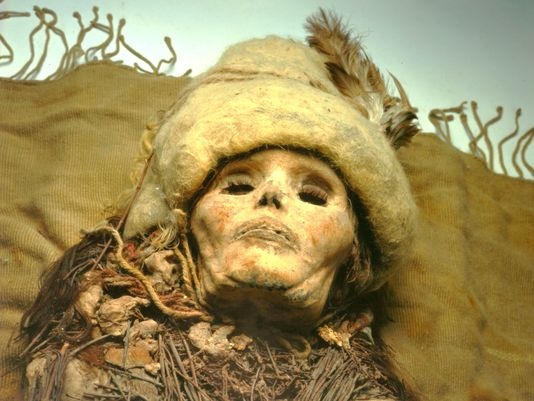
Clumps on the neck of this mummy from an ancient burial ground in the Chinese desert turned out to be ancient cheese, the oldest yet found.(Photo: Wang da Gang)
Remains discovered with mummies in China prove to be oldest known samples of cheese.
Vintage Gouda may be aged for five years, some cheddar for a decade. They're both under-ripe youngsters compared with yellowish clumps – found on the necks and chests of Chinese mummies – now revealed to be the world's oldest cheese.
The Chinese cheese dates back as early as 1615 BC, making it by far the most ancient ever discovered. Thanks to the quick decay of most dairy products, there isn't even a runner-up. The world's best-aged cheese seems to be a lactose-free variety that was quick and convenient to make and may have played a role in the spread of herding and dairying across Asia.
"We not only identified the product as the earliest known cheese, but we also have direct … evidence of ancient technology," says study author Andrej Shevchenko, an analytical chemist at Germany's Max Planck Institute of Molecular Cell Biology and Genetics. The method was "easy, cheap … It's a technology for the common people."
The cheese, like the mummies, owes its existence to the extraordinary conditions at Small River Cemetery Number 5, in northwestern China. First documented by a Swedish archaeologist in the 1930s, it sits in the fearsome Taklamakan Desert, one of the world's largest. A mysterious Bronze Age people buried dozens of their own atop a large sand dune near a now-dry river, interring their kin underneath what looks like large wooden boats. The boats were wrapped so snugly with cowhide that it's as if they'd been "vacuum-packed," Shevchenko says.
The combination of dry desert air and salty soil prevented decay to an extraordinary degree. The remains and grave goods were freeze-dried, preserving the light-brown hair and strangely non-Asian facial features of the dead along with their felt hats, wool capes and leather boots. Analysis of the plant seeds and animal tissues in the tombs showed the burials date to 1450 to 1650 BC.
Some of the bodies had oddly shaped crumbs on their necks and chests. By analyzing the proteins and fats in these clumps, Shevchenko and his colleagues determined that they're definitely cheese, not butter or milk. It's not clear why people were buried with bits of cheese on their bodies, Shevchenko says, though perhaps it was food for the afterlife.
The analysis also showed the mummies' cheese was made by combining milk with a "starter," a mix of bacteria and yeast. This technique is still used today to make kefir, a sour, slightly effervescent dairy beverage, and kefir cheese, similar to cottage cheese.
If the people of the cemetery did indeed rely on a kefir starter to make cheese, they were contradicting the conventional wisdom. Most cheese today is made not with a kefir starter but with rennet, a substance from the guts of a calf, lamb or kid that curdles milk. Cheese was supposedly invented by accident when humans began carrying milk in bags made of animal gut.
Making cheese with rennet requires the killing of a young animal, Shevchenko points out, and the kefir method does not. He argues that the ease and low cost of the kefir method would have helped drive the spread of herding throughout Asia from its origins in the Middle East. Even better, both kefir and kefir cheese are low in lactose, making them edible for the lactose-intolerant inhabitants of Asia. The new results are reported in an upcoming issue of the Journal of Archaeological Science.
Scientists have found fragments of cheese-making strainers in Poland that date back more than 7,000 years, and there are Danish pots from 5,000 years ago that hold what may be butter or cheese, says bioarchaeologist Oliver Craig of the University of York in Britain. But he agrees that Shevchenko's team has good evidence that their cheese is the record-holder for age.
Craig is more cautious about the new study's suggestion that the cheese was made with kefir starter rather than rennet. That's harder to prove, he says, because the proteins could have decayed too much to provide a definitive answer. He thinks a study of animal bones or pottery is needed to confirm that the cheese at the cemetery was part of a technological spread across Asia.
Whether the cheese was common in its day, it's exceptional now. Usually if a dairy product is left to its own devices, "bacteria will get in and start to eat it away, liquefy it," Craig says. "It's just amazing it survived."
Source: USA TODAY
Annex News - Tech



